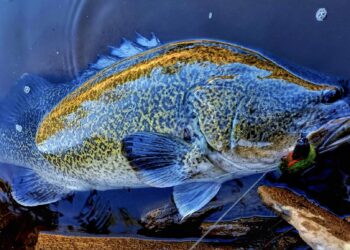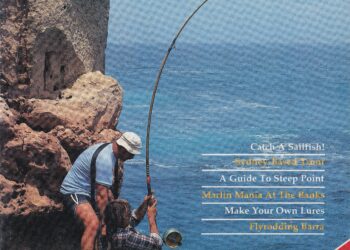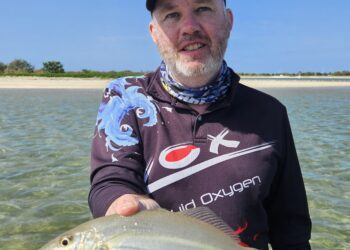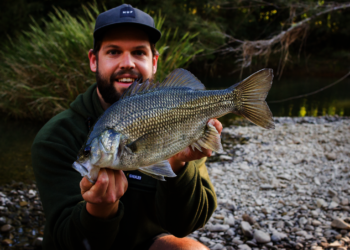FINESSE fishing is popular with anglers around the nation, and with good reason. It’s seriously addictive and can be extremely productive. While light tackle sportfishing has been around for years, modern tackle technology now sees more anglers targeting larger fish on lighter gear. Fishos who employ patience and skill are often rewarded with some exceptional catches.
Bread & butter species like bream, flathead and whiting are commonly targeted with standard light spin gear involving 6lb braid and 10lb leader. However, this gear can also be used to good effect on more prestigious species such as barramundi, mangrove jacks and threadfin/blue salmon. Most fishos probably think these species require the use of heavier gear. After all, barra and jacks are well known as being tackle destroyers, right?
Yes, but that doesn’t mean you can’t target these and other species on much lighter gear than you might think possible. Tropical finesse fishing is absolutely dynamite and extremely addictive. You may lose the occasional fish but this is more than compensated for by the extra strikes received as a result of going light. The fun factor is often enhanced as well. It’s well known that you get far more bites while utilising lighter gear, especially in hard-fished waters. What mightn’t be as well known is how effective “bream gear” can be on hard-fighting Aussie sportfish. That said, getting the strike and hooking the fish is the easy part. Landing the fish requires a perfectly set drag, advanced fish fighting skills and a fair degree of patience.
I’m using a 2-6lb Samurai Reaction 203 Estuary rod and Shimano Rarenium 2500Ci4 reel as my finesse fishing combo and find it absolutely ideal for this style of fishing. As mentioned above, you do need to adjust your techniques to suit the tackle. Go too hard on a fish and you’ll likely pop the leader knot. On the flip side, surely it’s better to go too light and lose the occasional fish, than go too heavy and not get the bite to begin with? It’s a bit of a catch 22, but to me the answer is a no-brainer.
Lately, I’ve been fortunate enough to hook and land good numbers of barramundi, blue salmon, javelin fish and even a few large mangrove jacks on my light outfit. It’s been great fun and a huge challenge. Re-running those electrifying sessions through my mind at night has kept me wide awake long after my head had hit the pillow. I’m sure other anglers who have encountered decent fish on this type of equipment can attest to the absolute adrenalin rush that light tackle sportfishing can give you. It’s certainly got me hooked.
This type of fishing isn’t for everyone and there are definitely applications where I wouldn’t consider or recommend it. One such situation would be live-baiting, which often requires the angler to let the fish engulf the herring or mullet. A light leader would rub through on a raspy jaw plate or get cut on sharp teeth. Finesse tackle isn’t the best here, instead you’d stick with traditional 40-60lb hard mono leaders and 20-30lb braid main lines.
Another situation where light tackle probably isn’t all that effective is when fishing areas of thick cover – for example, snags or mangrove edges – and rocky banks, reefs and bommies. Fish don’t have to move far in a snag or around mangrove roots to wrap you up. A proven tactic here is to immediately load up on the fish in an attempt to “bully” it out of the danger zones. Doing that with finesse gear will simply result in a bust-off. Heavy line and locked-up drags are needed in these situations – and even then many fish still manage to bury you. When it comes to rocks, most estuary and inshore anglers know all too well that line or leader touching or rubbing against a rock, especially a rock covered in jagged oyster shells, is always a recipe for trouble.
Most experienced lure casters will agree that heavier leaders of abrasion resistant mono or fluorocarbon are pretty much mandatory when casting lures or baits around rocky structure. In saying all that, there are certainly applications where specialised finesse scenarios are required. Using heavy gear will mean you just don’t get a bite. Targeting finicky jungle perch or sooty grunter in gin-clear rainforest streams is a good example of a fishery where going light definitely pays dividends. The use of a fluorocarbon leader is mandatory for this style of fishing, largely due to the fact fluorocarbon contains the same mirroring qualities as water and is therefore almost invisible.
Some of the best advice I have ever been given was to “pick my fights”. The same applies in fishing: knowing when – and when not – to utilise light tackle options is vital. The locations I fish allow me to utilise finesse techniques. This is due to the lack of significant hard structure. A creek near my home base of Mackay in central Queensland contains a shallow “run” which plummets away into a deeper section that contains a few oyster-encrusted rocks. The fish hang out on this gutter/drop-off and wait for food and bait to be swept past them on the receding tide.
I have no doubt that I’d hook far less fish if I was using heavier gear in this area. Also, I know for an absolute fact that I wouldn’t be able to cast extremely light soft plastics anywhere near as far as I do with the finesse tackle. I believe that there are a few other factors that have contributed to my strike rates of late. Atomic Plazo Prong soft plastics rigged weedless on Gamakatsu Worm Hooks have been something of a revelation for me. The Prong is a prawn profile and thus a good option in estuary situations. After all, prawns are on the menu for just about all of the common estuary species … Rigged weedless, the plastic can be cast into some pretty nasty structure – oyster encrusted rocks, mangrove roots and weedbeds – without snagging up as much as a traditional jig head or hard-body lure. As detailed previously, fish can easily bust you up in this sort of rugged country – but being able to work a lure effectively without getting snagged up as much certainly increases the chances of getting a solid bite. And there’s a lot to be said for the school of thought that advocates hooking up first and then worrying about what the fish does!
As with many of today’s innovative lure designs, the weedless plastic rig was originally designed for the American largemouth bass circuit. In the States, bass anglers cast weedless plastics into thick stands of acquatic vegetation, prime habitat for hungry bass. As already explained, you can bounce weedless rigged plastics over the worst structure imaginable and they will rarely hook up; however, when a fish bites down, the plastic compresses into the gape of the hook and the point gets exposed. You may miss the occasional strike, but I reckon the benefits of almost complete snag resistance far outweigh a few missed hook-ups.
Another advantage concerns the shape of the hook. At least 90 per cent of the fish I’ve hooked on weedless worm hooks have been pinned fair in the jaw hinge. Barramundi and salmon (blue and threadfin) have abrasive jaws and are notorious for rasping through even quite heavy leaders. Hooking the fish in the corner of the jaw allows for much lighter leaders, which aid in presentation and are much harder for the fish to see. There’s probably much more work and thought to be put into this but at this stage my work utilising worm hooks in my rigs leads me to think it allows for a better hook-up placement, negating the need for a heavier leader and allowing the use of finesse fishing techniques.
Another important element in finesse fishing involves a well-set drag. I’ve had conversations with various mates who spend the majority of their time live-baiting. They use 20lb braid, 40-60lb leader and tighten the drag to within an inch of its life. Despite this, they still get busted off. They can’t fathom how I can use such light equipment and manage to land most of my fish. I look at it logically. It’s obvious that the tighter the drag, the more pressure is exerted at any given point on the line. Any slight abrasion or poorly tied knot offers a weak point. It’s here that the line will break once significant pressure is applied.
By setting the drag lightly, it lessens the strain on the line and allows the fish to run. As long as there’s nowhere for the fish to stitch you up, and presuming you fight the fish efficiently, you should get it in. This was brought home recently when a lovely 63cm blue salmon had taken my three-inch Prong down its throat a little deeper than the jaw hinge. The drag was set lightly and due to the absence of rugged structure, I was able to take my time with the fish. After a 15-minute battle, I landed the fish, pulled on both ends of the leader and it broke easily. I have no doubt that if I’d done the drag up tighter, it would have exerted more pressure on the weakened leader and the fish would have been lost as a result.
As already stated, finesse fishing isn’t for everyone. However, it amplifies the angling entertainment factor, gets more strikes and fine tunes your skill and ability. As such, it’s definitely worth including in your angling repertoire.




















